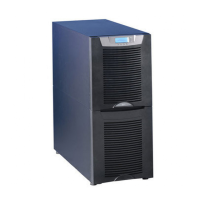12 Eaton 9155 UPS (8–15 kVA) User’s Guide 164201553—Rev H0
• The newer, more energy efficient data center cooling methods (such as air side economization) can create
much wider ranges of temperature and Relative Humidity (RH) in the UPS room and/or data center. There
are two aspects of this increased operating environment that can, if ignored, create issues.
– One is the creation of microclimates, which are persistent variations of temperature and/or RH within
a single room. For example one side of the room is always cooler than the other side, no matter the
actual temperature.
– The other aspect is the rate of change of temperature and/or RH, which can occur during transitions
within the cooling system. Examples: changing the mixture ratio of inside versus outside air, or
external changes in the outside air when going from night to day, and back to night.
– When ignored, either one of these aspects can create an undesirable microclimate at the UPS
location. If the environment created by this microclimate exceeds the UPS operating specification, the
UPS reliability, over time, will be reduced. These same environmental extremes will also create
reliability concerns for any servers that are exposed to them.
Failure to follow guidelines may void your warranty.
The basic environmental requirements for operation of the UPS are:
• Ambient Temperature Range: 5–40°C (41–104°F)
• Recommended Operating Range: 5–40°C (41–104°F)
• Maximum Relative Humidity: 5–95%, noncondensing
CAUTION
If battery systems are located in the same room as the UPS, the battery manufacturer's environmental
requirements should be followed if they are more stringent than the UPS requirements. Operating
temperatures above the recommended range will result in decreased battery life and performance, and may
reduce or void the battery warranty.
The UPS ventilation requirements are shown in Table 1. To allow for future power upgrades, Eaton
recommends using air conditioning or ventilation sized for the fully rated UPS kVA installed instead of the
derated kVA ordered. Sizing the site cooling infrastructure to be capable of cooling the maximum kVA size will
allow a full power rating upgrade without having to modify the infrastructure.
Table 1. Air Conditioning or Ventilation Requirements During Full Load Operation
Model
UPS Rating Minimum Required Cooling Air Flow
Eaton 9155 UPS
8–15 kVA
129 liter/sec (274 cfm)
The UPS equipment operating environment must meet the weight requirements shown in Table 2 and the size
requirements shown in Table 3.
When planning the installation, consider the UPS weight for floor loading. The strength of the installation
surface must be adequate for point and distributed loadings. The approximate weights are shown in the
following table.
UPS Installation Plan and Unpacking

